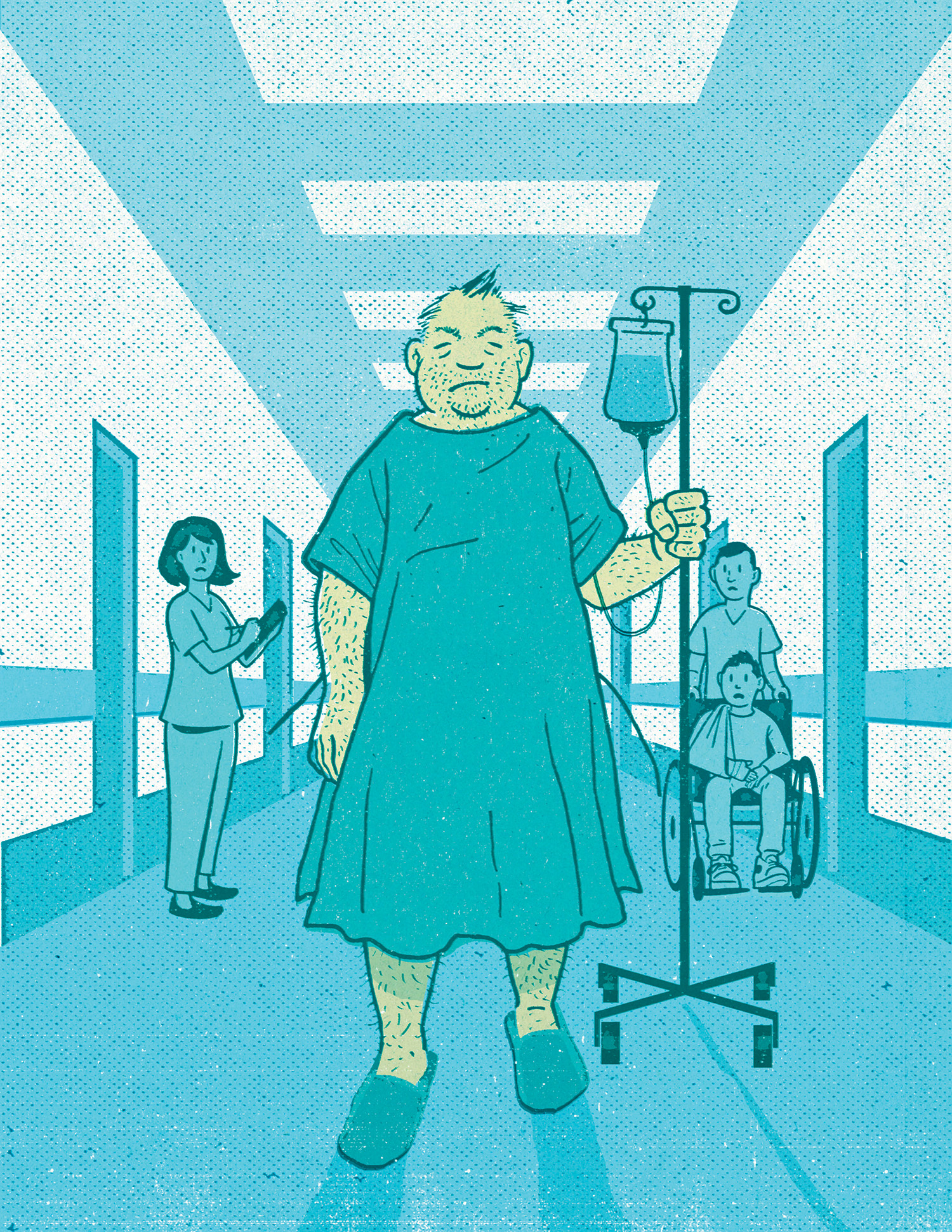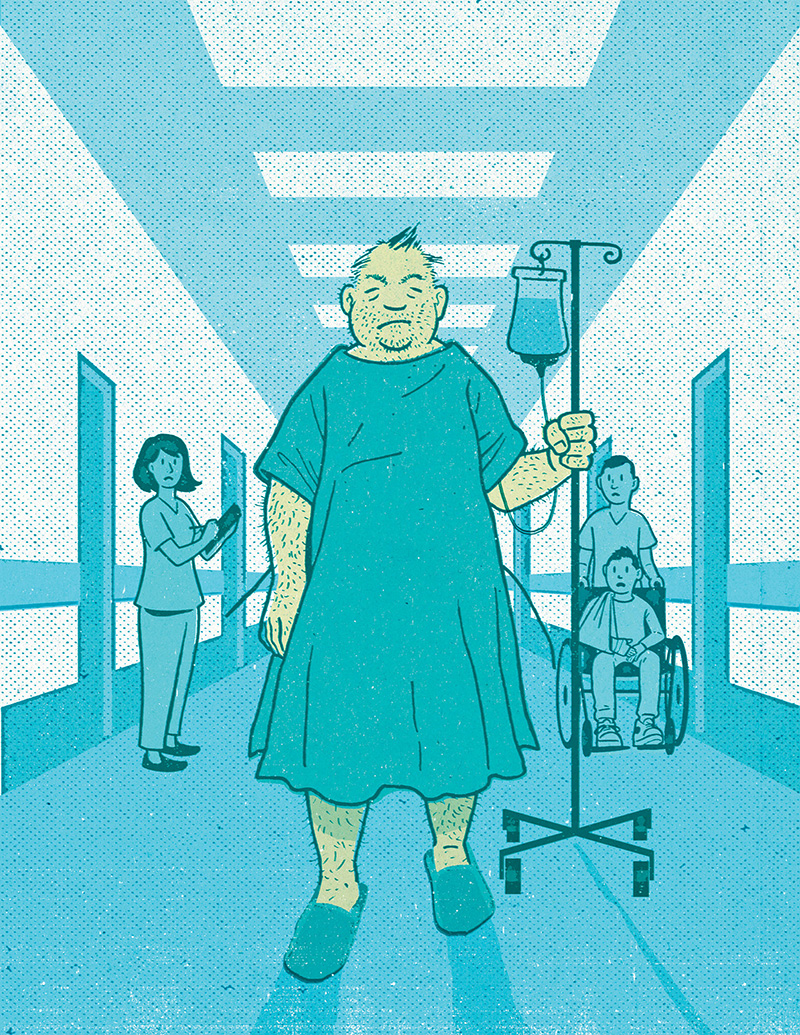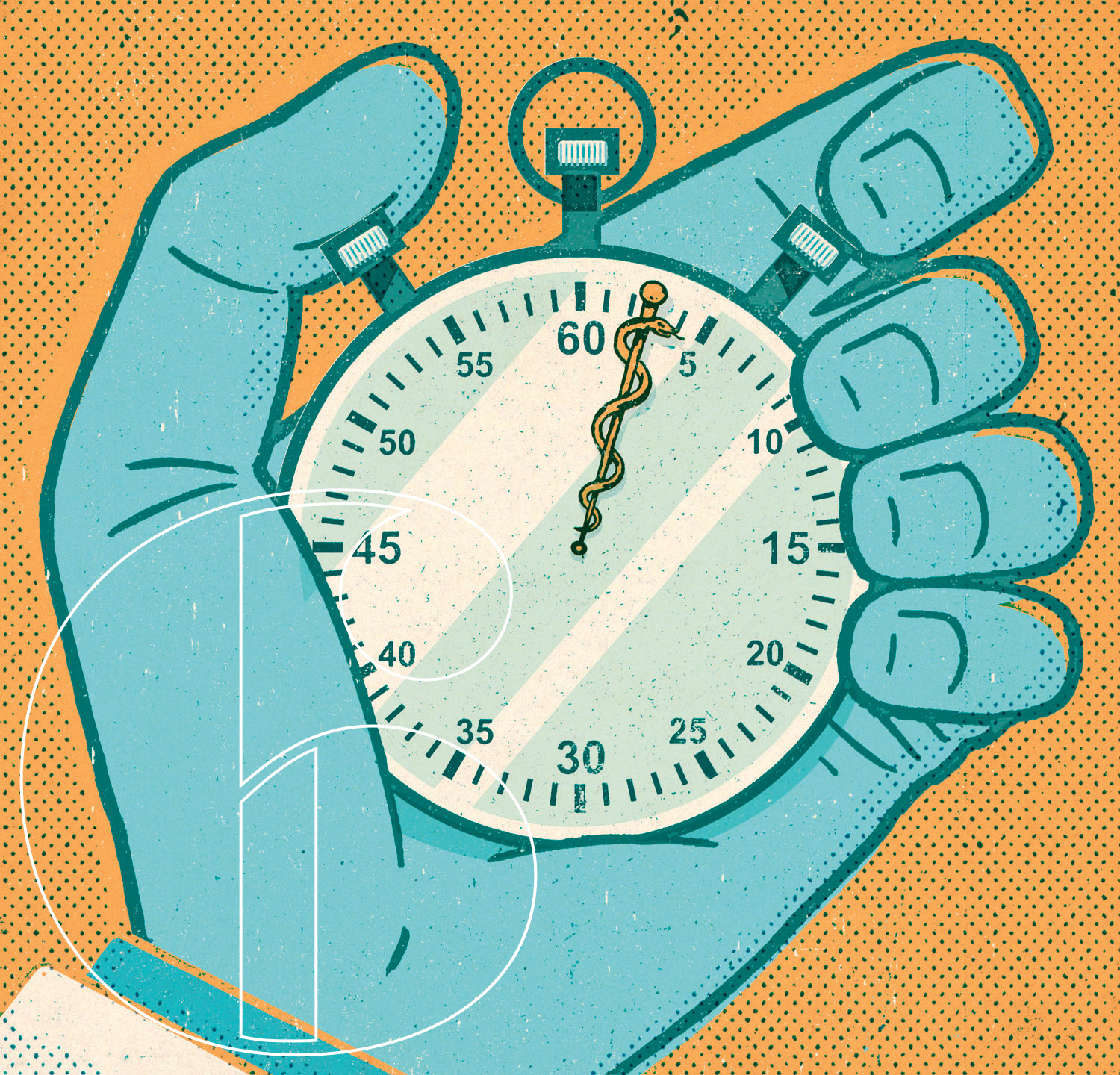

January | February 2015
Imagine getting a checkup by email.
Or using your smartphone to find a doctor the same way you find a restaurant.
Or a system that focuses as much on keeping you healthy as it does on healing your illness.
None of these things should be that hard to imagine. Transportation, entertainment, banking, and just about every other industry you can think of has been transformed by innovations that reduce cost, increase value, and improve our consumer experience.
Not health care. Yes, we’ve seen advances in things like devices and diagnostics, as well as scientific breakthroughs that have helped people beat diseases and live longer. But human-level advancements that help us live healthier, day in and day out? Not so much. Even little things that improve our consumer experience—like easier check depositing or reserving seats at a movie theater—have not hit health care.
Technology alone isn’t the answer, but there is a lot of potential. Even though exciting innovation and experimentation is happening all over the country, we don’t have the infrastructure or incentives in place to scale individual successes quickly.
Another part of the problem is the disconnect between what we pay for and the value we receive. Health care has been built on a fee-for-service model that pays more for doing more, particularly high-end procedures and expensive tests. The economic incentives to do more are strong, but the incentives to produce better health and improve value are much weaker.
In the spirit of moving some needed changes along, and with due respect to David Letterman, here are my top 10 reasons why we know the health care system is broken, and some recommendations for fixes.

Hospital gowns expose your rear end when you get out of bed.
I’m joking with this one—kind of. People assume there’s a good reason hospital gowns are designed the way they are, but those gowns create more problems than they solve.
It’s not clear where the design originated, but by most accounts, the open-in-the-back gown has been ubiquitous in American health care settings for at least a century.
When I think of how many complaints about these gowns I’ve heard from patients through the years, it’s clear we need a fix. Considering that the healing process often involves getting up and moving around, we are actually giving patients a disincentive when they can’t get out of bed without exposing more of themselves than they want to. And they aren’t really designed to make doctors’ or nurses’ jobs easier; we’d rather see an opening in the front to make it easier to listen to hearts and bellies.
Doctors and patients deal with basic inefficiencies like this throughout their day, and the fact that they are just part of the drill has helped them escape scrutiny.
There have been attempts at a redesign, including a collaboration between the Cleveland Clinic and fashion designer Diane von Furstenberg, but none have really caught on. The bigger point is that doctors and patients deal with basic inefficiencies like this throughout their day, and the fact that they are just part of the drill has helped them escape scrutiny.
Is it a case of “doctor knows best”? Respect for tradition? The complexity of the system? Who knows.
Regardless, there has to be a better solution.
Health care is even more expensive than you think.
In 2012, the U.S. spent nearly $9,000 per person on health care—equivalent to roughly 17 percent of our gross domestic product (GDP). That’s more than any other nation on the planet. We’re making a staggering investment and getting relatively little in terms of better health outcomes. The World Health Organization ranks us after Costa Rica, and just ahead of Slovenia and Cuba, in terms of overall health system performance, and we spend much, much more than each of them.
In 1980, U.S. health care costs were in line with other countries; care accounted for about as much of GDP as it did in other wealthy countries, like Sweden and Denmark. But inflation has been brutal. If food price inflation since 1945 matched that of health care, today we would be paying $55 for a dozen eggs.
If food price inflation since 1945 matched that of health care, today we would be paying $55 for a dozen eggs.
There are many contributors to the excessive cost of health care in America. A recent report from the Institute of Medicine estimated that 30 percent of the U.S. health care bill is waste. The biggest piece of this, accounting for $210 billion in spending, is unnecessary services: extra tests and procedures that provide no real benefit, or even cause harm. Inefficiently delivered services and excessive administrative costs are other big contributors.
Other industries have focused on efficiencies and appropriateness with great impact. Just look at the Internet, computers, and software for nearly all information-intensive businesses. It wasn’t that long ago that you had to stand in line at a bank and speak to a teller to deposit or cash a check, and only during limited weekday hours. Now you can deposit checks and retrieve cash any time and in multiple ways, with less effort required by you and the bank.
We need to bring the same innovation to health care systems. If we start to reimburse for value of care rather than quantity, we will see the systems adapt. This won’t be easy, as it will require orchestrating providers, insurers, patients, and other disjointed interests. But there are ways of pushing this forward.
Imagine an entrepreneur with a smartphone-based device designed to reduce costs and improve outcomes for diabetes care, and paying that entrepreneur part of the money the system saves. This form of value-based reimbursement will encourage more such entrepreneurs and support a system that is moving in the right direction.
A good doctor is much harder to find than a good restaurant.
If I want to take my family out to dinner, I can grab my smartphone and find just about any restaurant. I can see what’s good, what’s close, what’s open, what’s being served and what it costs, and when the next table is available. It’s that easy.
The system is ordering for you, choosing your server, and not telling you how much anything will cost until months later.
Why is it so difficult to find a doctor? Why does it take so much work to figure out whether that doctor accepts your insurance or is taking new patients, let alone if he has a pleasant bedside manner?
The problem here is the disjointed system. Who would pay for this kind of service? Your insurance company doesn’t benefit. Your doctor might, but only if she is taking new patients and you have good insurance. In health care, not only is the system picking your restaurant, it is also ordering for you, choosing your server, and not telling you how much anything will cost until months later.
Technology needs to transform health care at a human level, the same way it’s transformed smartphones and dinner reservations. This will only happen if entrepreneurs have an opportunity to introduce innovations that someone will pay for. Value-based reimbursement gets us closer to a better system that will reward new and disruptive ideas like OpenTable and Uber, but applied to health care.
Nearly half of Americans don’t take their medications as prescribed.
No one reminds you to take your meds.
Meds don’t work if you don’t take them. And they often work well if you do. Obvious, right?
So why is it that nearly half of Americans don’t take their medications as prescribed? They may not take pills at the right times or even have prescriptions filled. That’s bad for those individuals, whose illnesses aren’t being treated. And it’s bad for the system, which incurs billions of dollars in unnecessary health care costs.
Again, technology can help. Our phones already light up when bills are due or there’s a discounted airfare to our favorite destination. There’s no reason why we shouldn’t be getting an automated reminder from our doctor or pharmacist when it’s time to take a pill or get a prescription refilled.
Doctor visits are way too short.
A patient speaks for less than two minutes in an average private practice, primary care office visit. That’s barely enough time to ask a single question.
Patients don’t want shorter doctor visits. They want real office visits, appointments during which physicians really listen to what’s going on, explain health issues, and help patients get well.
Doctors want the same thing.
Physicians and other health care professionals want to spend time getting to know patients. They want to understand a patient’s health concerns and become a partner in improving their health. It’s not possible to do that when primary care visits don’t allow time for meaningful discussion.
Unfortunately, the fee-for-service model, being paid for seeing more patients rather than for achieving results, is one of the major drivers of our health care system. It’s not saving us money and no one likes it—not patients, not doctors—but everyone is stuck with it.
But what if doctors and the systems they work in were paid for keeping blood pressure controlled rather than for office visits? Then we could think about a system in which blood pressure was managed through a Bluetooth-enabled blood pressure cuff linked to an app and transmitted to a pharmacist overseeing 1,000 patients with hypertension. This would eliminate the need for the monthly four-minute visits and leave time for a meaningful 30-minute visit with the patient to discuss the potential impact of high blood pressure, the choice of meds, and concerns about possible side effects. This would be cheaper, better for patients, and better for docs.

When you have the flu, you have to get out of bed and drive to a crowded office.
This one is crazy.
You’re sick! You don’t want to have to get into your car, drive 15 minutes to your doctor’s office, wait for 45 minutes to see your doctor—only to be told to pick up some Tylenol—and then drive 15 minutes back home. This is the kind of thing that could be easily be managed by phone, which is better for you and considerably lowers the odds that you’ll get anyone in the crowded waiting room sick.
The main reason this doesn’t happen today is because no one pays for this telephone and video visit. The doctor only gets paid if you make the trip. The flu is relatively easy to diagnose and treat, and only a fraction of patients with flu-like symptoms actually need an exam. An even smaller fraction need a prescription. Paying based on value opens up the system to better solutions, tying payments to whether you have a better experience and better outcomes no matter how you “see” a doctor.
You can’t find an apple in a vending machine.
Every workday, I pass one of the millions of vending machines in America filled with sugary sodas and candy. If we were truly focused on health and prevention of disease, wouldn’t we have an opportunity to choose healthy foods from a vending machine?
This is an issue even in hospitals, where generous contracts with vendors often dictate available food choices.
In an ideal health system, the focus would be on ways to link all of the elements that contribute to the health of the community, including upstream factors that could eliminate the doctor visit in the first place.
If one takes a broader perspective about health care, issues like what’s available in a vending machine become relevant, not just because it’s good to think about keeping people healthier, but because the financial and workforce implications of not keeping them healthy are much greater.
You’re seeing too much of the back of your doctor’s head.
Electronic health records (EHRs) should be so helpful. They’re comprehensive, up-to-the-minute snapshots and histories showing what’s going on with patients and their care. They should make it easier for doctors to diagnose health issues and prescribe effective treatments.
At the moment, however, they’re not making anyone happy. Doctors are especially frustrated because so much of their time is spent entering data into a computer. And that frustrates patients, who end up hearing what they just said repeated into a microphone, or staring at the back of the doctor’s head, listening to typing. Current EHRs just aren’t up to the task and have been focused more on making billing more efficient rather than on improving care. Okay, it’s new technology, but let’s hope we can move beyond the Zork years.
You can’t email your doctor (or at least most of us can’t).

Think about that flu experience from above—where you spend 75 minutes traveling to and from a doctor’s appointment that’s over in just a few minutes. In every other sector of our economy that sort of thing is handled by email; in medicine, we’re using a version of the Pony Express. Questions about possible side effects, urinary tract infections, high blood pressure management … these are all types of patient interactions that could be managed, at least in part, through email communication.
Although some progressive hospital systems in the U.S. are demonstrating that email communication between providers and patients has various benefits—including a decrease in in-person patient visits—we still aren’t seeing widespread adoption.
A big reason for that is doctors don’t get paid for answering emails. But they should. Electronic communication has the potential to save both the patient and the doctor a lot of time, not to mention gasoline, and to provide better care to boot.
Hardly anyone pays for prevention.
Nearly half of all American adults—almost 120 million people—are suffering from a chronic disease such as stroke, diabetes, heart disease, or hypertension (high blood pressure), according to U.S. Centers for Disease Control estimates. These are among the most expensive health problems. They’re also among the most preventable.
I’m a neurologist specializing in stroke care. For issues like high blood pressure, a major risk factor for stroke, imagine if doctors like me were paid to encourage preventive care before a stroke hits. Better yet, what if physicians were thinking about prevention across whole communities, not just for individual patients? What if pharmacists played a larger role? What if we used technology in new and better ways?
What if physicians were thinking about prevention across whole communities, not just for individual patients?
Kaiser Permanente, for example, has demonstrated that these types of approaches can work. They reviewed their electronic records and identified patients with diabetes or high blood pressure. A nurse or other practitioner then worked directly with the patients to develop a plan to get these problems under control. Kaiser Permanente’s rates of blood pressure control are now higher than in any other system, with control in the 80 percent range compared to a national average of 64 percent. That played a part in moving heart disease, previously and nearly universally the No. 1 killer, down to the No. 2 slot for Kaiser enrollees, below cancer.
This was a great model program that made sense only because all the incentives were aligned for Kaiser to promote health, and they understood that they would eventually pay the consequences of not managing these risk factors. They are the insurer and also own the hospitals and pay the doctors. That confluence is unusual in the U.S. The key is to create similarly aligned incentives without necessarily consolidating ownership into large managed-care organizations.
If we can do this, the potential cost savings could be huge—patients would benefit, and doctors would have an even bigger impact on keeping people healthy. Hey, if we get it right, we could keep people out of the hospital and avoid the indignity of those hospital gowns.
Clay Johnston is the inaugural Dean of the Dell Medical School at UT-Austin.






























